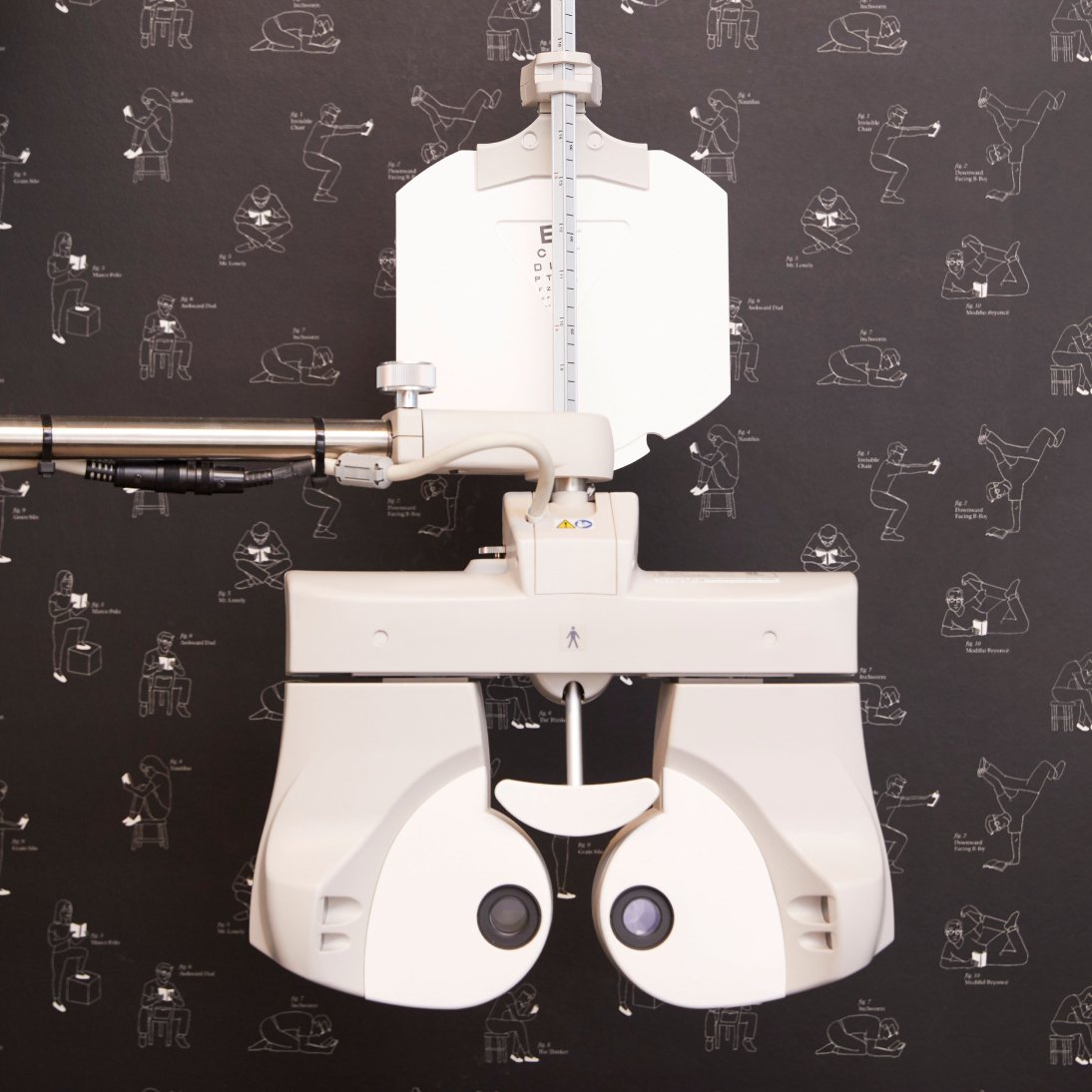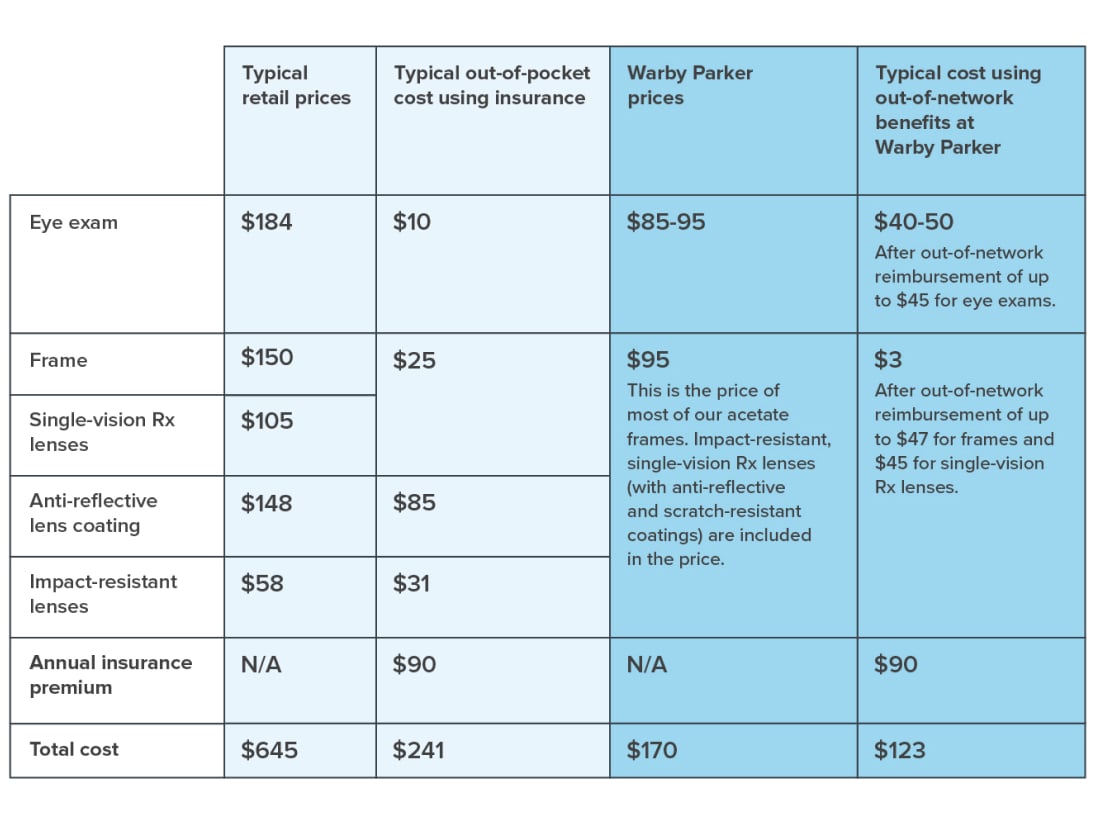According to the World Health Organization, every one of us can expect to experience an eye condition at some point in our lives. With more than 2 billion people in the world in need of vision correction—a number growing by the day—the importance of regular eye exams cannot be overstated.
Vision insurance is meant to help with the cost of these exams and prescription eyewear. However, given all the systems at play, it can be hard to understand exactly how vision insurance works. You might be wondering how it differs from general health insurance, how much money it might save you, and whether it’s worth paying premiums if you don’t know whether you’ll need glasses or contacts in the future.
Our guide to vision insurance will address these questions and more. If you’re asking yourself, “Should I get vision insurance?,” then this explainer is for you.
How Does Vision Insurance Work?
When you have vision insurance, you typically pay a monthly or annual premium in exchange for coverage of (or a discount on) various eye care services. Your plan may be associated with a group of eye care providers and optical retailers that are “in-network,” but often plans also include “out-of-network” benefits to allow you to see other providers.
Different vision insurance plans will have different benefits, so it’s essential that you review your unique vision needs and what each plan offers before committing to one.
Is Vision Insurance Different From Health Insurance?
Yes! Whereas health insurance covers you during general medical services and emergencies, vision insurance has a much more specific scope: It normally applies just to eye exams, eyewear, and contacts. Vision insurance doesn’t typically cover emergency eye health issues—you need your “regular” health insurance for that.
Most health insurance plans do not cover what vision insurance covers, and the two kinds of insurance have separate plans and premiums. If you have health insurance (whether through your employer or independently), it probably does not include coverage for an annual eye exam and prescription eyewear or contact lenses.
Here’s where it gets a little confusing: Your health insurance likely does cover you in the event of eye-related injury, emergency, or disease. If you experience trauma to your eye or you’re being treated for glaucoma, for example, you’d use your general health insurance for those visits.
On the other hand, if you’re getting a routine eye exam and subsequent eyewear prescription, you’d use vision insurance.
Read more: What’s the Difference Between an Optometrist and an Ophthalmologist?
How Does Vision Insurance Save Me Money?
Vision insurance can operate in a few ways:
- It can give you a discount (e.g., 15%) on eligible services and products
- It can entirely or partially cover eligible services and products (with or without a copay)
- It can provide a set amount of money (an “allowance”) to help pay for certain products
Vision insurance plans can use one or more of the above methods to help with your eye care costs.
What Are the Types of Vision Insurance?
There are vision insurance plans available for individuals, couples, and families.
Like health insurance, your plan may be affiliated with a PPO (Preferred Provider Organization) or an HMO (Health Maintenance Organization). PPO plans allow you greater freedom when selecting a provider, who can be in- or out-of-network. HMOs are often more affordable but more restrictive, requiring you to see in-network providers.
Just like health insurance, vision insurance can be independently purchased or be a part of your employer’s benefits package. Either way, you’ll pay a set amount each month (the premium) to the insurance provider in exchange for their version of benefits.
What Does Vision Insurance Cover?
Vision insurance usually covers comprehensive eye exams as well as some types of prescription eyewear and contact lenses.
These benefits may apply to purchases made in-network only. However, many plans will offer full or partial reimbursement after you buy eyewear or contact lenses from an out-of-network provider. Warby Parker makes it especially easy to use your insurance benefits or apply for reimbursement when you shop with us.
The exact mix of benefits varies from plan to plan—read on for some common examples.
Are Eye Exams Covered by Vision Insurance?
Yes, vision insurance almost always provides coverage for annual eye exams. Your plan might cover the exam completely or require a copay—a set amount you pay for a service that’s much lower than the cost would be without insurance. Often, copays for an eye exam fall in the range of $10–$20.
How much are eye exams without insurance, you ask? Around $100 or more on average, but there’s a lot of variation from office to office.
Read more: How Much Is an Eye Exam?
Does Vision Insurance Cover Glasses?
Vision insurance usually covers at least a portion of the price you’ll pay for glasses. Some plans will give you a discount on the cost of frames and lenses; others will pay up to a certain amount (an “allowance”) and then require you to make up the difference.
Most vision insurance plans differentiate between glasses frames and lenses when determining their coverage. For example, your plan might cover up to $135 of the price of frames, and cover the cost of basic lenses completely. Another plan might cover the first $100 you pay for frames and have a $25 copay for basic prescription lenses. Make sure to pay attention to both aspects of your plan!
Additionally, your plan may or may not cover lens enhancements. You might need to pay the full cost or a set out-of-pocket price for add-ons like polycarbonate lenses, scratch-resistant coating, or UV protection. (At Warby Parker, we include these elements as standard in the price of every single one of our frames—there’s no additional cost to you.)
If you’re looking to get these or other specialized lens treatments—progressive lenses, light-responsive lenses, blue-light-filtering lenses, etc.—you should first review your vision insurance benefits to see if they’ll help with the cost.
One last, important thing to note: Vision insurance often covers a limited number of glasses purchases over a set period of time. You might be able to use your benefits on one set of frames and lenses every year or every two years. Make sure you check your plan details so you know how frequently you can use your benefits!
Does Vision Insurance Cover Contacts?
Some vision insurance plans cover contact lenses the same way they might cover glasses: with an allowance or a discount. Others might only cover glasses.
If your plan offers some amount of coverage for glasses and contacts, keep in mind that you may have to choose between them. Check with your provider to see if the plan will cover one or both types of vision correction in the time window allotted (usually every one to two years).
How much are contacts without insurance? The short answer is: It depends on what type of contact lens you’re buying. The long answer can be found here: How Much Are Contact Lenses?
Does Vision Insurance Cover Eye Surgery?
Vision insurance doesn’t usually cover eye surgery. Some plans offer a discount on surgical procedures that correct your vision, such as LASIK and PRK. But this is a far less common offering than the benefits related to glasses and contacts.
How Much Is Vision Insurance Per Month?
Monthly vision insurance premiums cost approximately $5–$30 a month per person. Plans with more comprehensive benefits will be on the more expensive end of this scale, and plans without too many bells and whistles will be more affordable.
Family plans have higher monthly premiums, but if you have enough people on your plan (e.g. two parents with children), the cost per person can sometimes end up being less than you’d pay with an individual plan.
Is Vision Insurance Worth It?
It could be worth having vision insurance if you plan on scheduling annual eye exams, and it’s especially worth it if you also plan on purchasing eyewear or contacts during the year.
According to the American Academy of Ophthalmology, you should be getting eye exams more frequently as you get older and your risk for certain eye conditions increases. (Remember, presbyopia affects everyone at some point in middle age!) If you’re in your 20s or 30s, an annual eye exam may not be warranted—though you should always make an appointment if you’re experiencing any eye-related symptoms.
Whether or not vision insurance is worth it for you will therefore depend on how often you go in for exams and how often you purchase glasses or contacts. If you’re doing both of these things once a year, vision insurance is likely a good choice.
How Much Can I Save With Vision Insurance?
Vision insurance can save you hundreds of dollars a year. The chart below shows an example of how much you might save on an eye exam and a pair of single-vision glasses with vision insurance vs. without it—even if you go out of your plan’s network.
Do I Need Vision Insurance to Get an Eye Exam?
No, optometrists do not require you to have vision insurance before they administer an eye exam. However, the cost of seeing an eye doctor without insurance will be greater than seeing one with it.
Should I Get Vision Insurance if I Don’t Wear Glasses or Contacts?
Yes, if you can enroll in a plan that ultimately saves you money. Even if you only get an eye exam with no eyewear, the annual cost of insurance may be below what you’d pay for an uninsured exam.
Compare the annual cost of vision insurance to the cost of an eye exam to determine whether enrolling in vision insurance makes sense for you. During an eye exam, in addition to determining your eye prescription, optometrists can detect eye disorders and diseases that may require treatment—and the earlier they spot them, the better.
Enrolling in vision insurance through your employer can also save you some money, as the cost of the premium is often deducted from your paycheck before it’s taxed.
Do I Need Vision Insurance?
To decide whether or not you need vision insurance, you’ll have to answer some key questions.
- Are you willing to pay a monthly premium for long-term savings on eye exams and eyewear?
- What types of services and products would your plan cover?
- Will you shop for glasses or contacts often enough to get the most out of your benefits?
- How much does your insurance reimburse you for out-of-network services and purchases?
- Would an FSA (flexible spending account) or HSA (health savings account) be a better fit for your lifestyle?
Now that you know how vision insurance works, you’re all the more qualified to weigh its pros and cons for your peepers.







